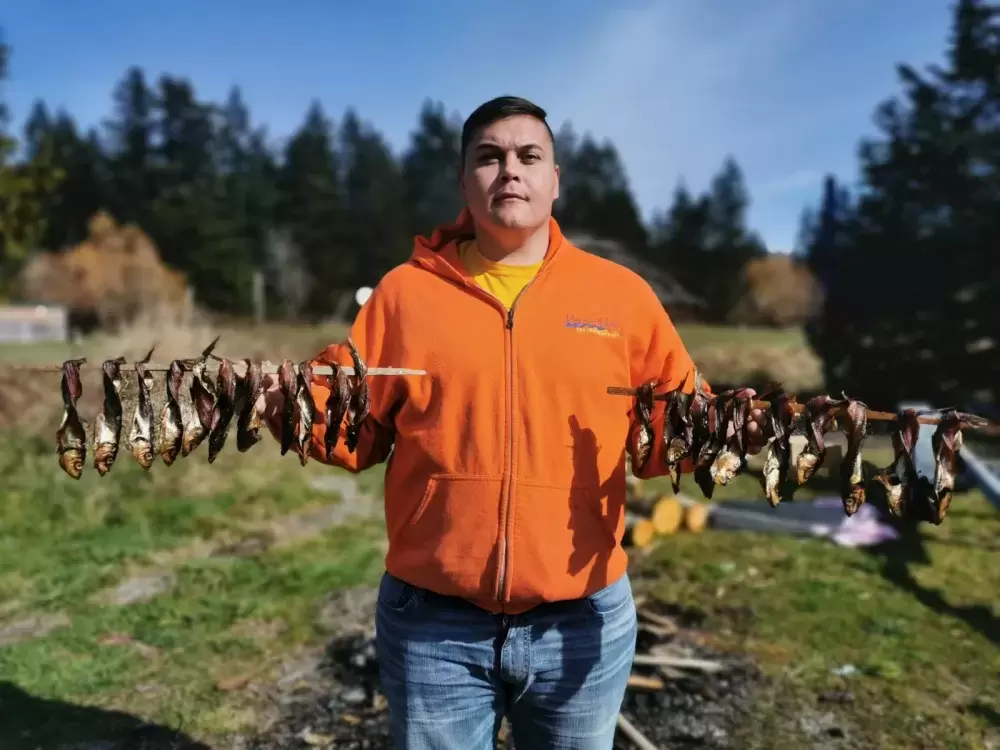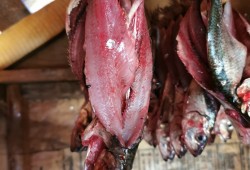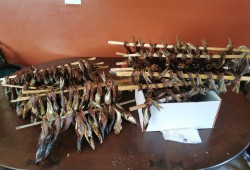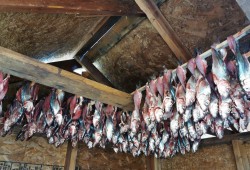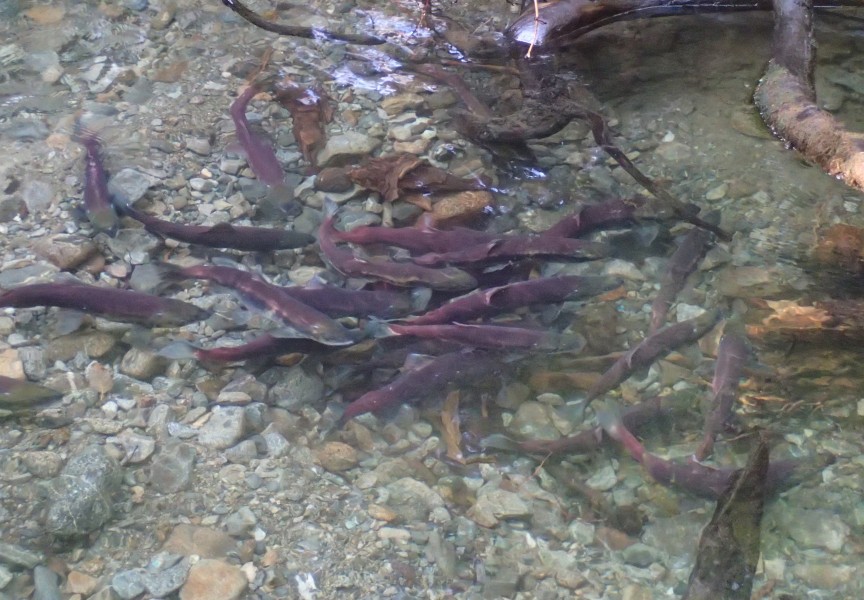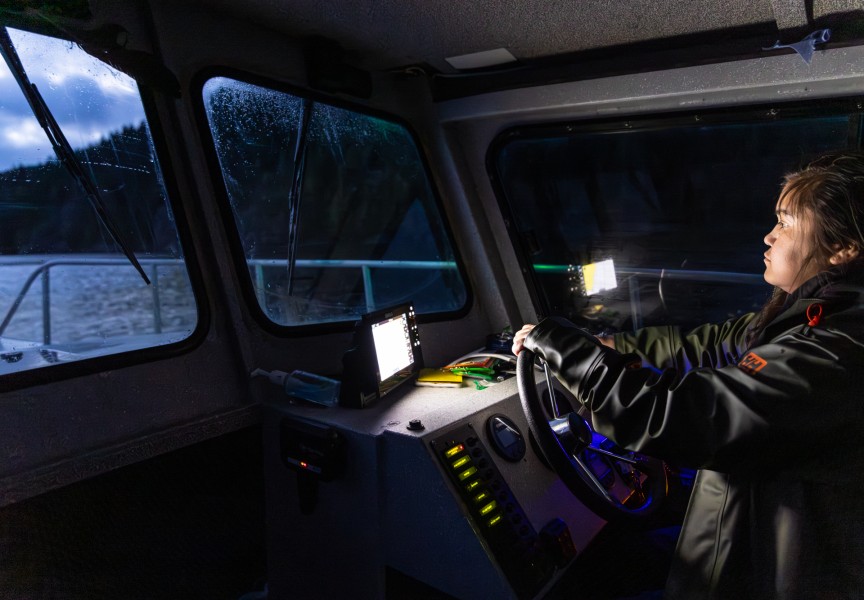Outside of their Port Alberni home, Hesquiaht elected chief Joshua Charleson and his wife, Letitia, were busy at work preparing herring for their smokehouse.
Having only smoked herring once before, Letitia was supported through the process by Charleson, who was taught by his mother.
Growing up in an urban setting outside her traditional territory, Letitia was never exposed to the tradition. Despite being well-versed in smoking salmon, she said herring is entirely different.
Unlike salmon, the head and tail are left intact on herring. Once gutted, its spine is sliced and the fish is flipped inside-out before being hung side-by-side on wooden sticks inside the smokehouse, explained Letitia.
“I love it,” she said. “Just being able to practice and also having our children around watching and learning. Sometimes they help, sometimes they don’t, but just knowing that they’re around and that they can see these teachings is what [excites] me. Eventually when they’re older, they will be familiar with this and they’ll know how to do it on their own.”
Because of the smoke omission, Letitia said First Nations people who live in urban centres often get complaints from neighbours or landlords when using their smokehouse.
“Living away from your territory plays a huge factor in not being able to keep those traditions alive,” she said.
That, and the declining fish stock.
Out of five regions on B.C.’s coast where the fish are monitored, only the Strait of Georgia experienced a biomass volume capable of having a commercial herring fishery this year.
The west coast of Vancouver Island (WCVI) hasn’t been able to support a commercial fishery since 2005 and is only open for small-scale First Nations food, social and ceremonial (FSC) purposes.
According to the Department of Fisheries and Oceans Canada’s (DFO) 2020/21 Pacific Herring Integrated Fisheries Management Plan, the WCVI stock persisted in a low biomass and productivity state from approximately 2004 to 2014.
While recent years have shown an increasing trend, persistent low biomass and growth relative to historic levels means that the region’s commercial fishery has been kept closed to support rebuilding.
Back in the day, inches of herring roe would coat the kelp, said Jared Dick, Uu-a-thluk central region biologist.
Now, only thin layers of eggs around one or two centimetres in thickness are laid, he said.
“DFO’s models and science say it’s improving,” said Dick. “But Indigenous knowledge and local knowledge and understanding of what a healthy population looks like [indicates] that we’re nowhere near where we should be.”
In 2015, DFO partnered with Nuu-chah-nulth nations to launch a five-year pilot study to establish an annual nearshore sampling program for WCVI herring.
The program was geared towards sampling mature herring from active spawning sites using small hand-thrown cast nets. Along with the cast net sampling, the nations supported stock assessment by identifying and locating herring spawning events and performing surface surveys of herring egg deposition, said Alexandra Coutts, DFO communications advisor.
Throughout those years, the age and size data for the cast net sampling was compared to DFO’s seine boat data.
“We’ve shown that our cast net sampling produces the same data as the seine boat sampling,” said Dick.
As a result, the nations’ data is being incorporated into DFO’s annual stock assessment for the second year, he said.
“The Nuu-chah-nulth’s nations’ involvement in the WCVI herring stock assessment program enhances the department’s collective understanding of herring abundance, distribution and recovery,” said Coutts.
Carlos Mack has been conducting herring surveys for DFO through Toquaht Nation for the past five years. Continually “amazed” by the amount of life spawning herring attract, it’s a job he takes pride in.
And yet, he can’t help but feel disappointed by this year’s spawning events.
Speaking over the hum of his engine while conducting a herring survey in front of Macoah village on March 12, Mack said, “It wasn’t as great as we thought it would be. The numbers are slowly coming up, but it’s really slow.”
Before moving to his next location, Mack anchored a pile cedar branches to a boulder and dropped them into the ocean near the spawning grounds. It’s a method used to harvest herring eggs that are deposited on the surface of the branches during a spawning event. Requested by Toquaht elected chief Anne Mack, the branches are later distributed to community members, who peel the eggs off the branches for consumption.
The tradition is so ingrained into the fabric of Nuu-chah-nulth culture that Hesquiaht’s name is derived from the very act.
“We are ḥiškʷiiʔatḥ and the sound of repeatedly pulling the eel grass between the teeth is ḥišḥiiša,” said chuutsqa L. Rorick, who coordinates Hesquiaht’s language program. “We are the people that pull eel grass between our teeth to eat the herring roe.”
A seine boat under contract to DFO through the Herring Conservation and Research Society began its charter to obtain biological samples on Feb. 20. Starting in Barkley Sound, the Proud Canadian travelled north through Clayoquot and Nootka Sounds to Esperanza Inlet before returning south to end its charter back in Barkley Sound on March 11.
At the request of local First Nations, the vessel retained “small quantities” of whole herring for FSC purposes for local Nuu-chah-nulth nations, said Coutts.
During a test in Sydney Inlet, Hesquiaht Fisheries received around one-tonne of herring from the Proud Canadian for distribution in Hot Springs Cove, and another half-tonne for Hesquiaht members living in Port Alberni, said Charleson.
While the Hesquiaht chief said few people continue to smoke herring, the time-consuming process is “well worth it.”
Once finished smoking their herring, Charleson and Letitia packed the fish up to store in their freezer.
Depending on how much they give away to family and friends, their stash is usually gone before summer.
“I’m so grateful I’m with somebody whose family still keeps these traditions alive,” said Letitia.

